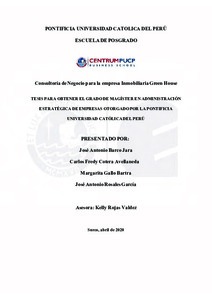| dc.contributor.advisor | Rojas Valdez, Kelly | |
| dc.contributor.author | Barco Jara, José Antonio | |
| dc.contributor.author | Cotera Avellaneda, Carlos Fredy | |
| dc.contributor.author | Gallo Bartra, Margarita | |
| dc.contributor.author | Rosales García, José Antonio | |
| dc.date.accessioned | 2020-05-14T05:50:44Z | |
| dc.date.available | 2020-05-14T05:50:44Z | |
| dc.date.created | 2020-04 | |
| dc.date.issued | 2020-05-14 | |
| dc.identifier.uri | http://hdl.handle.net/20.500.12404/16192 | |
| dc.description.abstract | Inmobiliaria Green House es una empresa especializada en el desarrollo de proyectos
inmobiliarios, que inició operaciones en el año 2009 en la ciudad de Huancayo. Su principal
línea de negocios es la construcción y comercialización de departamentos en edificios
multifamiliares dirigidos al sector C y D, pero eventualmente participa también como
proveedor de servicios de acabado y mantenimiento en proyectos e instalaciones de terceros,
mayoritariamente en contrataciones con el Estado. En los últimos años, Green House
experimentó un gran crecimiento en sus operaciones, alcanzado una facturación promedio de
S/ 5.4 millones anuales en el periodo del 2016 al 2018 gracias al mayor tamaño de sus
proyectos. Sin embargo, en este periodo de análisis, también enfrentó serias limitaciones para
la generación de utilidades, obteniendo un margen neto promedio de 4.2% y llegando en el
2018 al valor mínimo en su historia de 0.8%.
En el diagnóstico empresarial se determinó que el problema central de Green House
es que no se está generando una rentabilidad que justifique la inversión, y el objetivo de esta
consultoría fue identificar las principales causas que han dado origen a dicho problema, para
proponer un plan de mejoras que permitan revertirlo. Posteriormente se concluyó que las
causas de la baja rentabilidad de Green House que tuvieron mayor impacto en sus recientes
resultados fueron: (a) la ausencia de gestión estratégica y generación de indicadores, (b) una
inadecuada gestión de marketing, y (c) fallas en el aseguramiento de la calidad.
Se propuso la implementación inmediata de siete iniciativas englobadas en tres
soluciones: (a) diseño y mejora del plan estratégico, (b) implementación de plan de marketing
y ventas; y (c) estandarización y mejora del proceso de aseguramiento de la calidad . El
beneficio esperado de esta implementación en un escenario conservador sería de S/ 1,740,318
y ayudaría a Green House a alcanzar su nueva meta de rentabilidad, que, durante la etapa de
consultoría, la empresa precisó en un 10% de margen de utilidad neta. | es_ES |
| dc.description.abstract | Inmobiliaria Green House is a company specialized in the development of real estate
projects, which began operations in 2009 in the city of Huancayo. Its main line of business is
the construction and commercialization of departments in multi-family buildings aimed at
sector C and D, but eventually it also participates as a provider of finishing and maintenance
services in third-party projects and facilities, mostly in contracts with the State. In recent
years, Green House experienced a great growth in its operations, reaching an average
turnover of S/ 5.4 million soles per year in the period from 2016 to 2018 thanks to the larger
size of its projects. However, in this period of analysis, it also faced serious limitations for the
generation of profits, obtaining an average net margin of 4.2% and reaching the minimum
value in its history of 0.8% in 2018.
In the business diagnosis, it was determined that the central problem of Green House
is that it is not generating a profitability that justifies the investment, and the objective of this
consultancy was to identify the main causes that have given rise to this problem, in order to
propose a plan of improvements that will allow it to be reversed. Then, it was concluded that
the causes of the low profitability of Green House that have had the greatest impact on its
recent results were (a) the absence of strategic management and generation of indicators, (b)
a poor marketing management, and (c) failures in quality assurance.
Seven initiatives were proposed for immediate implementation, grouped into three
solutions: (a) design and improvement of the strategic plan; (b) implementation of the
marketing and sales plan; and (c) standardization and improvement of the quality assurance
process. The expected benefit of the implementation in a conservative scenario would be S/
1,740,318 and would help Green House to reach its new profitability goal, which during the
consulting phase, the company set at 10% net profit margin. | es_ES |
| dc.language.iso | spa | es_ES |
| dc.publisher | Pontificia Universidad Católica del Perú | es_ES |
| dc.rights | info:eu-repo/semantics/closedAccess | es_ES |
| dc.subject | Consultoría | es_ES |
| dc.subject | Proyectos inmobiliarios--Perú | es_ES |
| dc.subject | Sector construcción--Perú | es_ES |
| dc.title | Consultoría de negocio para la empresa Inmobiliaria Green House | es_ES |
| dc.type | info:eu-repo/semantics/masterThesis | es_ES |
| thesis.degree.name | Maestro en Administración Estratégica de Empresas | es_ES |
| thesis.degree.level | Maestría | es_ES |
| thesis.degree.grantor | Pontificia Universidad Católica del Perú. CENTRUM | es_ES |
| thesis.degree.discipline | Administración Estratégica de Empresas | es_ES |
| renati.advisor.dni | 41038596 | |
| renati.advisor.orcid | https://orcid.org/0000-0002-4866-1671 | es_ES |
| renati.author.dni | 10052153 | |
| renati.author.dni | 20063177 | |
| renati.author.dni | 70433779 | |
| renati.author.dni | 20113728 | |
| renati.discipline | 413307 | es_ES |
| renati.level | https://purl.org/pe-repo/renati/level#maestro | es_ES |
| renati.type | https://purl.org/pe-repo/renati/type#tesis | es_ES |
| dc.publisher.country | PE | es_ES |
| dc.subject.ocde | https://purl.org/pe-repo/ocde/ford#5.02.04 | es_ES |





